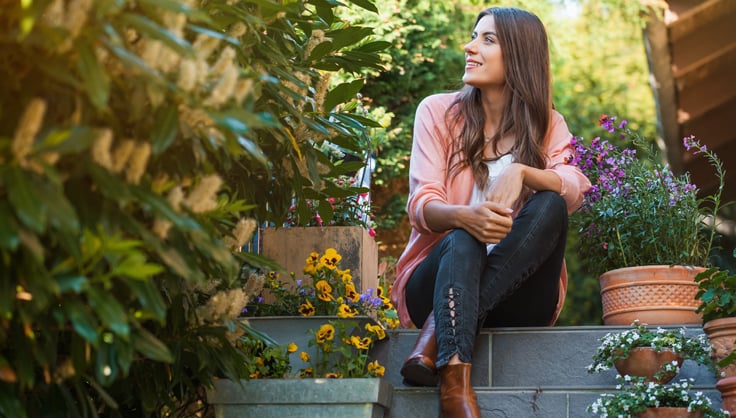Garden Bathing
Get your feet (and nothing else) wet with this calming mindfulness technique

You may have heard of forest bathing, a practice of deeply tuning into the natural world in a forest setting, using mindfulness techniques and heightened sensory awareness. But garden bathing can provide the same benefits without even leaving your yard.
Also known as shinrin-yoku, the practice of forest bathing began in Japan, but has spread throughout the world via books, peer-reviewed research, and forest bathing workshops, as people have experienced increased happiness and improved health by simply spending intentional time in nature.
Using the same principles, you can turn your meditative garden sanctuary into a sanctuary of garden meditation. Garden bathing can unlock new facets of your awareness, your emotional and spiritual well-being, and your garden (as if you needed an excuse to spend more time in the garden). It’s easy to try, and even a few minutes a week has been shown to produce far-reaching benefits.
Why Bathing?
Okay, first off, as some of you are obviously wondering: why is it called “bathing”? No need to grab a towel — garden bathing is a practice of being wholly “in the moment,” taking the opportunity to immerse yourself in the sensory details all around you; letting the sights, sounds, smells, and textures of your garden wash over you and cleanse your worries and anxieties. So, leave the rubber ducky in the tub, and hopefully you can leave your stresses at the garden gate.
What is Garden Bathing?
In the simplest terms, garden bathing is a practice of deeply focusing your attention on what’s happening around you. By locking your focus onto the immediate sensory inputs, you are able to be more fully present, letting your garden’s natural beauty displace deadlines, to-do lists, and whatever else is overwhelming you. You’ll very quickly begin to notice garden goings-on that escape you when you’re busy spreading compost, pulling weeds, and gathering your harvest.
One of the big challenges for frequent gardeners is getting out of their usual gardening routine. Garden bathing is time spent intentionally in the garden, without doing any gardening. It may be hard at first to avoid seeing what tending needs to be done, but garden bathing is a practice, which means it gets easier and feels more natural the more you do it. So, don’t get discouraged if your first attempt at garden bathing isn’t all you hoped it would be.

The Benefits of Garden Bathing
While any good gardener knows the anecdotal benefits of spending time in your garden, research has shown that being intentional and consistent about spending non-gardening time in the garden has tons of positive health and wellness benefits.
According to Dr. Qing Li, the world's foremost expert in forest medicine and author of “Forest Bathing: How Trees Can Help You Find Health and Happiness,” mindful time in nature can significantly reduce stress levels and blood pressure, strengthen your cardiovascular and immune systems, and even boost concentration, creativity, mood, and energy levels. Among the burgeoning garden bathing movement, this time “just being” in the garden is known as “getting your dose of Vitamin G.”
How to Get Started with Garden Bathing
Garden bathing isn’t a science or a set of concrete rules. The tips below are simply suggestions to get you started and to help you tune into your garden in a deeper way. Find what works best for you, and then figure out how to increase your dosage of Vitamin G as much as your life allows!
-
Move slowly through the garden.
Slowing your body helps you relax and shift your attention.
-
Take time to sense what is around you.
Warm sun on your back, wind rustling flower heads, birds chirping, bees buzzing.
-
Find a seat. Breathe in deeply; slowly exhale.
Start to tune into the rhythms of your garden.
-
Notice colors. Focus on relaxing blues and greens.
Let your eyes go in and out of focus, taking it all in.
-
Watch the movement of leaves and insects.
Follow the busy routine of a bee, or zoom in on the subtle swaying of one plant.
-
Feel the textures surrounding you.
The grit of the soil, the bristles of a coneflower, the silky petals of a sunflower.
-
Breathe in scents, earthy and fragrant.
The sweet perfume of flowers, the heady aroma of fresh manure. Don’t judge, just notice.
-
Stay as long as you can.
This part should be easy. And remember, even a few minutes can work wonders.
Last updated: 09/14/2023
Print this Article:
Get the Dirt
Stay up to date on new articles and advice. Please fill out the information below.

